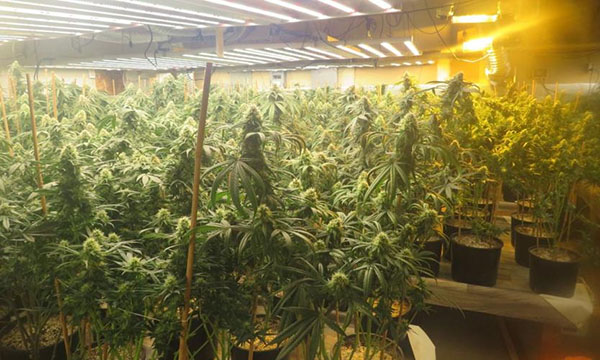Home Growers Produce Eight Times More Weed Than Colorado's Legal Market.

Home Growers Produce Eight Times More Weed Than Colorado's Legal Market.

A new report from cannabis data company New Frontier Data.
shows that U.S. home growers produced eight times more weed than the whole state of Colorado's legal weed market.
The newly released report on the home cultivation of marijuana in the United States has some interesting numbers.
The survey had a sample of nearly 6,000 cannabis consumers and non-consumers.
According to the report, marijuana growers are expected to harvest 11 million pounds of flower this year. To put that in perspective, Colorado's legal, and the commercial market grew just under 1.4 million pounds last year.
This means that home growers in the United States have cultivated nearly eight times as much as Colorado. That number is expected to grow to 15 million pounds by 2030.
The report also estimates that cannabis growers make up 6 percent of the cannabis community or more than 3 million people. That projection puts home cultivators of cannabis at about 1 percent of the U.S. population.
How much and how often do home growers produce?

Unsurprisingly, the report found that one of the main barriers to home growing is legality, with states with adult-use marijuana having more native growers than states with no legal markets or only medical markets.
In addition to this argument, another statistic shows that of all home growers surveyed, the majority (84%) have grown only in the last two years. This suggests that many only started cultivating after the state legalization. Both insights suggest that as more states legalize, more people will start growing at home.
Most home growers (73%) harvest 1 to 3 times per year, and 63% of harvests are less than 2 pounds, with 40% less than 1 pound.
It is worth noting that in most states where home growing is legal, the maximum number of mature plants a grower can have at any time is six or less. A plant grown indoors can take about 4 months to mature and yield around 1/4 pound of bud in dry weight.
A pound is about 454 grams, so the average person who smokes one gram a day will probably smoke less than a pound a year. The rest is likely used to make concentrate, edibles, or given away. This helps explain how a small fraction of the cannabis community (6%, according to the report) grows such a large crop of cannabis.
However, the total weight of harvest may include a lot of plant stems which could be wasted and account for some of the difference between the amount harvested and smoked.
There is some encouraging information for those looking to get into home cultivation:
Most home growers (65%) spend less than five hours a week looking after their crops. Also, half spend less than $500 to set up a home growth operation. Nearly 60 percent of growers said they spent less than $200 per harvest on seeds, supplies, utilities, and more, showing just how affordable home farming can be.
Even a tiny yield of 1/2lb per harvest can be worthwhile. Working out at about $200 for 225 grams, around $0.88 a gram (ignoring startup costs).
Home grower's demographics and behavior
The report also found that 60 percent of people grow indoors, while only 45 percent grow outdoors.
Outdoors is cheaper, often perceived as easier to grow, and requires fewer setup costs and utilities. This information means that most home growers either don't have the space to grow outdoors, want to harvest more each year, or want more control over the process. However, we should add that some states require home growers to keep plants indoors.
The report estimates that home growers currently spend up to $2.7 billion on equipment. This figure is expected to increase to $3.7 billion by 2030, indicating the huge revenue potential of the growing equipment market.
Another interesting piece of information is that home growers are mainly people with families. Of those surveyed, more than half (51 percent) were married, and about two-thirds (65 percent) had children, dispelling the idea of a lone grower living off the grid in the middle of the woods.
Home growers also have a wide range of incomes: almost half (45 %) earn less than $50,000 a year, while 25 percent earn more than $100,000, meaning people don't always grow their own because it's cheaper.
According to the report, these are the top five reasons people grow weed at home:
"It's as a hobby"
"It's cheaper"
"It's more convenient"
"I don't have to worry about chemicals/pesticides"
"I can grow better quality weed than I could buy elsewhere"
Disclaimer
While the report from New Frontier provides plenty of insight into the home growing market, it's important to note that they're based on a sample of 6,000 growers. That sample can be extrapolated to millions or hundreds of millions of people in the dataset, as in the case of projecting the total number of native U.S. growers. It has a population of about 330 million, so any minor variants in the dataset would be hugely magnified in the extrapolation and may not be a true reflection of the facts.
As with all data in the cannabis industry, exact numbers are difficult to pin down because the plant remains illegal at the federal level and is not adequately tracked. We must rely on forecasts and estimates, and it's hard to fully represent a market.
Regardless, New Frontier's report reveals a surprising insight into the landscape of marijuana home cultivation in what may be the most extensive examination to date, providing consumers and industry insiders with valuable information about this little-known market and its potential growth.





